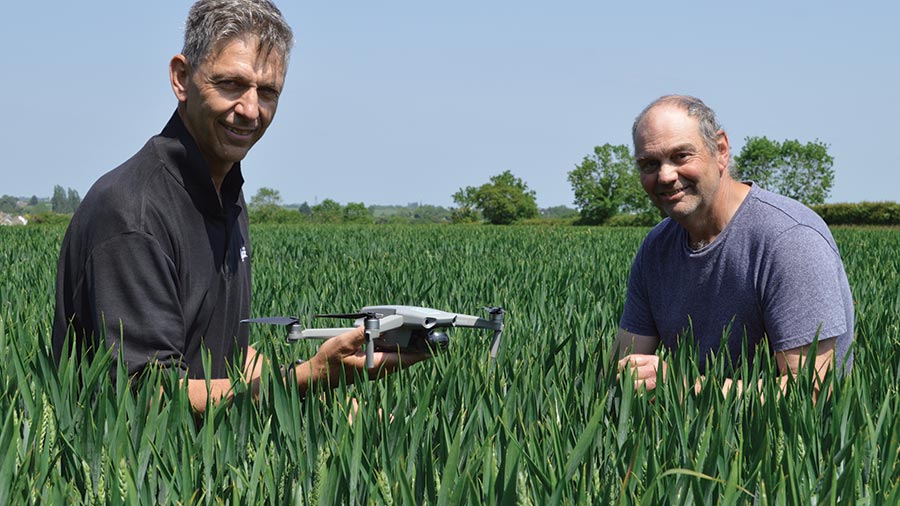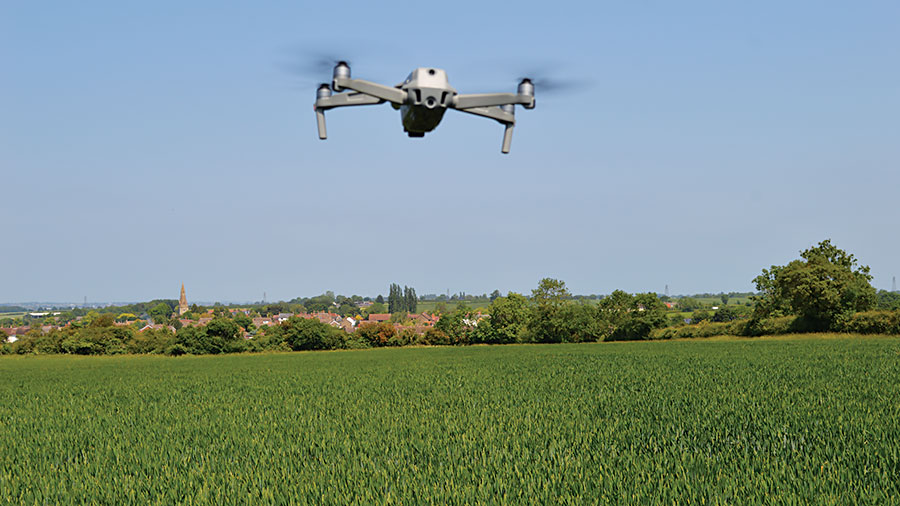Northants wheat grower cuts his nitrogen by using a drone
 Andrew Lowe (holding drone) and Will Green © MAG/David Jones
Andrew Lowe (holding drone) and Will Green © MAG/David Jones Will Green is using a drone on his Northamptonshire farm to cut his nitrogen fertiliser use by nearly a third on his winter wheat destined to make breakfast cereal at the nearby Weetabix factory.
Multiple photographic images taken across his wheat fields are cross-referenced with soil nitrogen test results, allowing him to trim ammonium nitrate rates by nearly 70kg/ha without any effect on yield, and with a benefit to profits and the environment.
The drone service is provided free by his agronomist, Andrew Lowe of advisory group Agrii, who sees improving crop nutrition as the first big gain from using drones, with better weed and disease control and a yield prediction application to come later.
See also: A wheat grower’s 4 tests to get nitrogen application rates spot on
Time saving
The ability of the drone to scan crops quickly means it can give accurate plant counts to feed into nitrogen fertiliser programmes, rather than Will or Andrew having to spend many hours assessing crops manually, and they have just finished their third season using the technology.
“We are always looking at ways of improving efficiency, and the saving in fertiliser is welcome, while we can also look out for poor patches of crops which may be due to bad drainage or pest damage,” says Will.
The first step in giving the wheat crop just the right amount of nutrition is to undertake a soil mineral nitrogen test (SMN) to determine the nitrogen in the soil in the early spring. The drone is then used to measure the green area index (GAI) which will give a value of how thick or thin the wheat crop is.
Andrew says: “With the SMN and GAI numbers together and with a realistic yield assessment, we can then work out exactly the right amount of nitrogen the crop needs and not provide nitrogen for the next crop.
“Will’s contract with Weetabix does not specify a protein content, so we can fine-tune nitrogen applications precisely to the yield target without worrying too much about building protein. Ultimately, it’s about ensuring the right amount of nitrogen is applied to the crop in question, and if there is a saving that’s an added bonus.”
Environmental benefits
Andrew says using nitrogen wisely is increasingly important from environmental and carbon footprint perspectives, and this technology offers a viable way to avoid wastage, reduce nitrates entering watercourses, and cut potential ammonia losses to the atmosphere.
Flying the drone at 30m above the ground, Andrew can pick points where he needs to drop down to look at the crop in more detail. Photos can then be taken at these points some 1.5m above the crop.
The drone’s software gives a very accurate assessment of GAI across the field from multiple points, and is superior to satellite images as the drone can distinguish between crops and weeds, adds Andrew.
On Will’s farm, for winter wheat following spring oats there was seen to be more nitrogen in the soil than expected, suggesting the oat crop is less deserving of its reputation for scavenging for nutrition. For wheat following beans, it was found the beans were not leaving as much nitrogen in the soil as initially envisaged.
Will is growing 25-30ha of winter wheat on his 87ha family-owned arable operation at White House Farm, Bozeat, just east of Northampton, on heavy clay land, along with winter beans and winter rye.
Nitrogen needs
For harvest 2022, he grew the winter wheat variety Costello after oats, and he normally refers to the industry fertiliser bible, the AHDB’s RB209, to see what nitrogen fertiliser he would need to achieve his average yield of 8-8.5t/ha.
“We would normally stick pretty much to RB209 recommendations for fertiliser applications, which last year said we would need to apply 220kg/ha of nitrogen to achieve our target yield,” he says.
However, using the drone’s estimate of GAI and linking this back to the SMN tests, Agrii’s drone-based system showed one field needed only 151kg/ha of nitrogen, and so this was applied over three splits in March, April and May 2022. On two other fields, the recommendations came out at 152kg/ha and 162kg/ha of nitrogen.
The savings therefore ranged from 58kg/ha to 69kg/ha of nitrogen, which Will considers pretty sizeable, given the cost of nitrogen fertiliser at that time. It also meant a saving of 200-250kg of carbon dioxide equivalent per hectare.
“The highest yield came in at 9.4t/ha, pretty much the best we ever get here, with an average of 8.25t/ha, which, considering the massive savings we saw in fertiliser costs, was a great result,” he adds.
Long-term advantages
In the season for harvest 2021 – the first year he used the drone – the nitrogen fertiliser savings were up to 50kg/ha, so Will is convinced of the long-term advantages of the drone-based system.
For harvest 2023, he switched to wheat variety Dawsum, which has Costello in its parentage, and his wheat followed winter beans in the rotation. The technique again resulted in savings, but not quite as high as previously.
The RB209 calculation advised that 180kg/ha of nitrogen was needed for the wheat crop after beans, but the drone-based system assessed the crop’s nitrogen needs at just 147-160kg/ha, so there has been a further year of fertiliser savings.
The system is also useful for assessing plant counts across the whole farm, and is also more accurate than manual counts. This gives Will a good overview of his crops which could highlight areas of bad drainage and damaged soil structure.
“We can map the whole farm in about two hours, rather than spending a couple of days crop walking and making a number of plant counts across square metres,” he says.
Aerial assessment

© MAG/David Jones
As the farm aims for a wheat plant count of 250-270/sq m, when an aerial assessment is made in the early spring, if the crop is thin then a plant growth regulator such as chlormequat can be used to improve tillering, or if the crop is too thick then nitrogen dose rates can be scaled back.
A further big advantage is that the system can tell how uniform the crop is, which can be a precursor to whether the grower should be using a variable-rate fertiliser application system.
“If you’re seeing 96% uniformity in your crops, there is little point in carrying out variable rate applications, whereas if it is 50% or 60%, there may be a case for this,” says Andrew.
The next step after crop nutrition and conducting plant counts could be weed and disease control.
Crops are analysed perhaps three or four times a year ahead of each potential split of nitrogen, and at the same time weed and disease hotspots can be monitored in the field that might not have easily been seen.
“Weed mapping is something we would like to get into eventually and the drone is also really useful in checking out dense crops such as oilseed rape and beans as they develop,” says Will.
Blackgrass assessments
One big advantage could be assessing blackgrass levels in the early summer and then planning a grassweed strategy for the next season based on where the severity of the blackgrass is the most critical.
“It’s much more accurate than satellite imagery which can only distinguish between brown and green,” says Andrew. “So if you have blackgrass in there or other weeds, the drone will allow us to filter all this out to give as accurate a GAI as possible.”
In the past 12 months, he says, Agrii has been concentrating on developing systems that can work in other crops such as oilseed rape and beans as well as winter wheat.
“It’s really useful in oilseed rape for the timing of the flowering spray for sclerotinia, for example, and also for the timing of the glyphosate pre-harvest timing,” he says.
“Trying to walk through a field of OSR when it is fully podded up is almost impossible. You get about 5m in and that’s about as far as you can go.”
The drone can tell the grower what stage of flowering the crop is at, assessing the whole field for a fungicide spray, and also how far podded the crop is, to help with the timing of glyphosate desiccation.
In addition, Agrii and drone supplier Drone AG are working on a prediction scheme for chocolate spot to assess disease levels in bean crops when it is often difficult to walk through a fully grown crop.
“We’re also using the drones to develop a wheat yield prediction system that, once a crop has headed up, will estimate what the yield of that field is going to be,” says Andrew.
Drone gains for the future
Increased productivity, cost reductions and helping the environment are some of the advantages that drones could bring to arable farming, says Agrii’s lead pilot and technology trial manager Jonathan Trotter.
“The potential is huge. We are already starting to use drones with our customers to identify early indications of potential localised problems such as nutrient deficiency or pest infestations before they become a major problem,” he says.
Jonathan sees many possibilities, from swarms of drones applying specific agrochemicals, to larger individual machines capable of carrying larger payloads, all of which could be controlled remotely and work with real-time data.
The issue moving forward is not the potential of the technology, he says, but ensuring it aligns with the legislation surrounding it and, to a degree, helping shape this.
This is why Agrii and Drone AG are working closely with the Civil Aviation Authority (CAA) and other key bodies to establish safe working practices and operational strategies for the future.
“We want to explore what is going to be possible and make sure it complies with all guidelines and legislation so growers and the wider industry can get the most benefit from aerial technologies,” says Jonathan.
Flying rules
Currently, the CAA allows drones up to 25kg to be flown with relevant qualifications. For bigger machines, there is a need to apply for an Operating Safety Case.
“So it could be that in a few years’ time we are looking at operating drones weighing closer to 80kg or 100kg. Whether we have one drone or a swarm of drones flying to apply fertiliser or pesticides – all in line with regulations, obviously – is something we are very keen to explore,” Jonathan says.
One possibility for the future, once legislation and authorisation with the CAA is agreed, is being able to pilot drones remotely from one of Agrii’s research and development technology centres. Although this will initially be used in R&D, the principles behind it could be used for collecting farm data at some later stage.
He explains: “The idea is we will be able to deploy ‘drone-in-the-box’ systems whereby we can place fully automated containers wherever we want, with a drone inside all pre-programmed and ready to go.
“We can then set it off autonomously, fly it over a field or trials site, collect high-resolution data, and it will then return to its box to be charged up again.”
At the moment, Agrii has several agronomists and crop input specialists trained to use drones, with more undergoing training for this potentially very valuable use of technology on farm.

